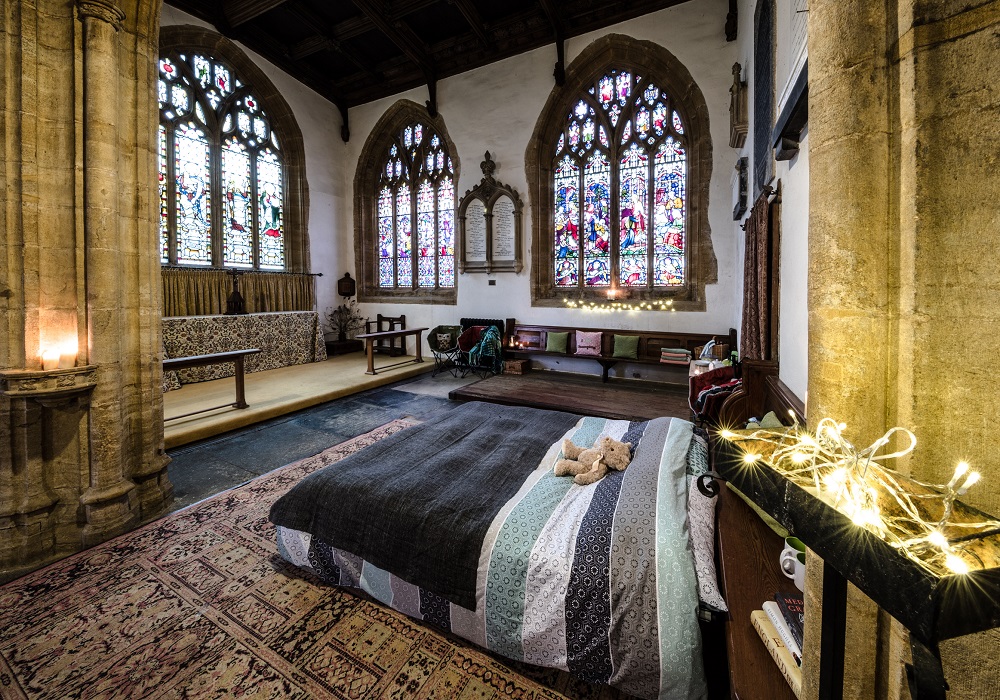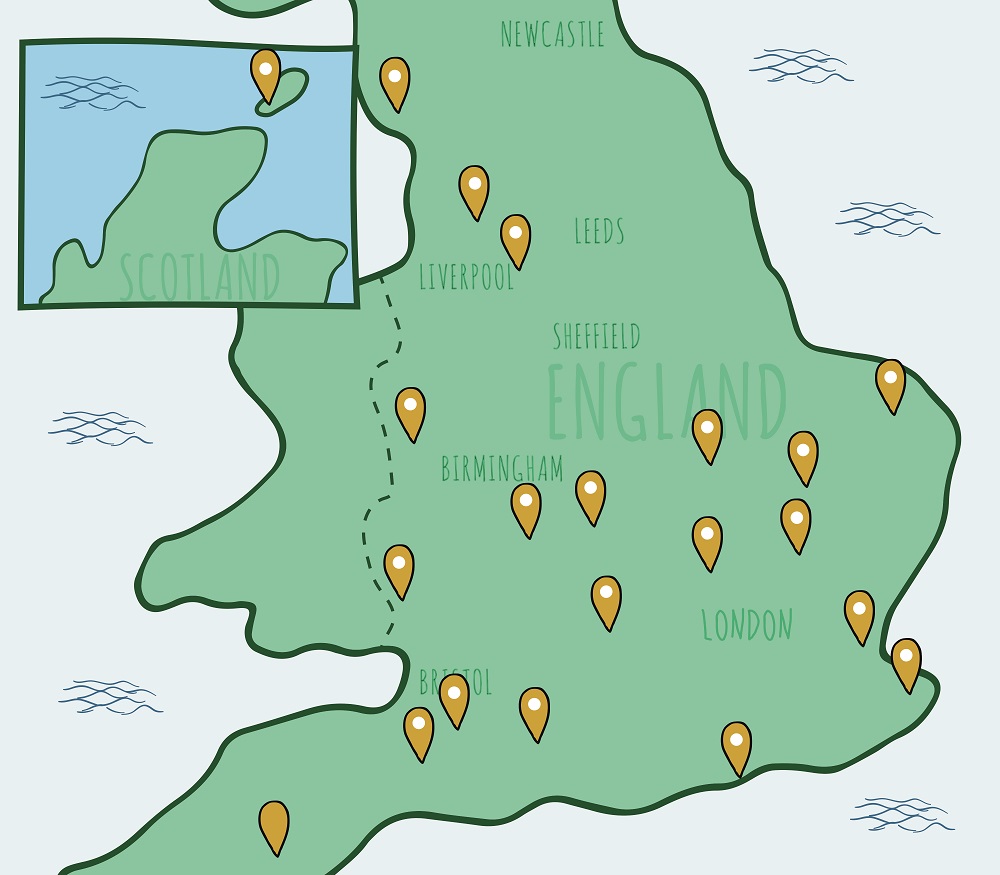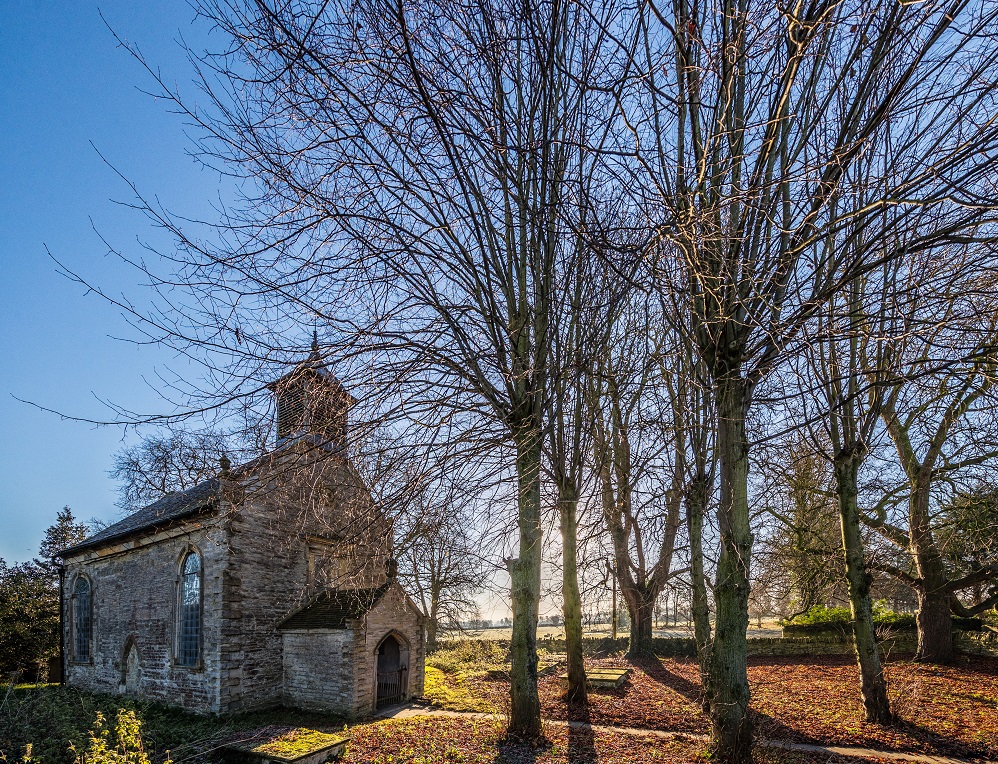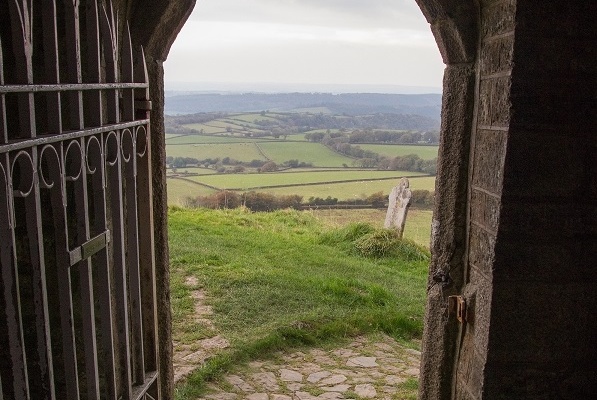If you want to do some glorious camping in the English countryside, ditch the idea of pitching a tiny tent at popular campgrounds (think crowded). Stay instead in charming old churches, which you can have all to yourself to have nothing but fun in! They’re more comfortable and protective, especially against the mercurial English weather; and they can also be divinely romantic.
Just imagine waking up in a comfy bed in All Saints’ Church, Langport with the sun jubilantly streaming through its stained-glass windows and birds chipperly chirping.
Rested, you walk out of your church (sounds cool right?) for a short, emerald-hued hike through magically receding mists – just some refreshing, appetite-boosting exercise before tucking into a fortifying country camper’s breakfast of hot bacon sandwiches and coffee.
Uum, are you feelin’ the spiritual sunshine of church camping?
We thought so. Consider settling into a pew of your very own then as we shepherd you through this relatively new experience.
They Call It ‘Champing’

All Saints’ Church in Langport, Somerset England. A comfy bed, a pillowed pew – the makings of a most agreeable champing experience! / Photo by Joseph Casey Photography. Courtesy of The Churches Conservation Trust.
Through a website run by The Churches Conservation Trust, you can rent any of about 20 or so churches in England and one (A simple lime-washed kirk!) in Orkney even, an archipelago near Scotland, for your heavenly camping holiday. The churches are medieval or have medieval roots. And when you go, you’ll be “champing,” a name coined and trademarked by the Trust to describe this new, recreational use for old churches.
Champing unites church and camping like glamping melds glamour and camping. And just as people who go glamping are called “glampers,” you’ll be a “champer.” If the lingo seems a little zany – a small adventure in itself – it simply reflects the quirky spirit of these fun alternatives to traditional camping, and, of course, efforts at branding them in the wilderness of outdoor offerings.
A London charity, the Trust saves old churches that are no longer regularly used for services from becoming the ruins of neglect over time. (It’s a kind of guardian angel of historic chapels.)
Changing demographics, oversupply, and dwindling congregations are the chief reasons why they’ve fallen into religious disuse. To raise funds for its conservation efforts, the Trust created champing. (Funny, we usually think of churches as saving souls instead of the other way around.) So camping in them qualifies as voluntourism, even though you don’t have to do any work – just enjoy yourself! (Ahmen to that!)
There’s a Champing Church for Everyone

General locations of the champing churches in England. / Map courtesy of The Churches Conservation Trust.
According to the Champing website, “You can take your pick from churches large and small, by riverbank or by moor, old and extremely old – there’s something for everyone.” But choosing may not be so easy since they all have charming histories and different architectural beauty, from Gothic to Georgian, from cavernous and elegant to small and cozy. Also, some have historical connections to important English writers and poets like Shakespeare, which will certainly appeal to lit lovers.
And several of them are in beautiful villages known for their excellent pubs, which may, in the end, be the deciding factor of your choice. (Cheers!)
Geographically speaking, the churches are fairly widely distributed, enabling you to merrily champ your way across much of the country if you want.
You can, for instance, champ from St Mary’s in Longsleddale, Cumbria in northwest England over to St. Thomas’ Church in Friarmere, Greater Manchester; then on to All Saints’ Church in Billesley in Warwickshire in the West Midlands; and, from there over to St. Mary’s Church in Edlesborough, about an hour outside of London; and, then to St. Andrew’s Church in Rollestone near the prehistoric monument of Stonehenge; and, finally, all the way down south to St. Mary the Virgin in Walkhampton, Devon.
The Champing Difference
Where camping means getting down to earth with nature; and, glamping means communing with nature from a cocoon of comfort; champing is a chance to reflect on nature’s maker, whoever or whatever you believe that to be. For, when staying in a church, your thoughts – even your dreams – easily turn, to some degree, to the creation of the universe and our place in it, or at least to how people thought about it all a long time ago.
Champing then can be a fascinating way to see the world through the magical lens of the folklore that still pervades the English countryside.
You may, for instance, see foliate heads, which have leaves and vines growing from their faces, that have been carved into the masonry of some of the medieval churches. They are thought to depict an ancient vegetation god who is half man and half shrub and who has come to be known as a “Green Man.” This god symbolizes mankind’s harmonious relationship with nature in ancient times and the cyclicality of Christianity. If you’ve ever listened to the song called “Jack in the Green” by Jethro Tull, the British rock band, then you’ve already been introduced.

“Green Man,” or Foliate Head, on the Chapter House at Southwell Minster Church in Southwell, Nottinghamshire, England. (This is not a champing church.) / Photo by Steve Cadman via Flickr. Creative Commons License 2.0
While camping is full of the ruggedness of fending for yourself in the wild; and glamping is being pampered along nature’s path, champing is a moderately comfortable way of experiencing the world of the pastoral English countryside and the Arcadian rhythms of its village life. We say “moderately comfortable” because while it offers more comfort than camping does, it provides less than glamping.
Sorry, but these churches just do not come with shower rooms, standard electricity, heat, Wi-Fi, cable/satellite TV, swimming pools, s’mores bars, sushi restaurants, etc. as glampsites often do. (Although, we never know when luxury “pods” might be coming to the Trust’s champing churches.)
With its lack of glitzy amenities (heavenly pun) then, champing can almost be considered a kind of…well…redemptive glamping, if you will; a welcome way to purge the excesses and spiritual encrustations that glamping can engender – leaving your soul lighter, more open to contemplation, tranquility, and inner peace.
Incidentally, how do you know if you’re an overly pampered glamper? Well, if you even ponder this question as you sip pinot noir and snack on s’mores at a glampsite, that’s a tip off. But look for other signs. If, for instance, you have a tantrum over spotty Wi-Fi, chuck your cell phone into a bush, and then dive right in after it, only to emerge covered in thorns – a horrific, unexpected reminder of camping – you probably need a little salvation. And church camping is right there to save you! (For having glamped, you can never really return to traditional camping anyway. Can you?)

All Saints’ Church in Billesley, Warwickshire England. / Photo by Joseph Casey Photography. Courtesy of The Churches Conservation Trust.
Like glamping, your stay in a church includes furniture such as regular beds, camp beds, chairs, and pews, and supplies such as lanterns and electric candles, tea and coffee making facilities, and some crockery. For extra fees, you can get a bedding set, which includes a sleeping bag and pillow; and, breakfast, which is either brought to you by a resident of a nearby village or served in an inn there.
What about bathrooms or loos, as they are called over there? Well, we think that the Champing website answers this question quite well:
“Some of our churches have flushing loos. Fancy. In our other churches we provide an eco-loo that runs on solar power; a new type of composting loo or “dry separating toilet” to give it the full technical language… We call it the ChampLav. This is very hygienic, non-whiffy and comfortable! These loos don’t require plumbing, water or a sewage outlet. In some of our churches we house them in little wooden cabins complete with gargoyle above the door. You really wouldn’t know the difference, but a word to the wise – sit down at all times, lads!”
So there you are then, sitting on your ChampLav with a trusty gargoyle to keep you company – a happy champer, indeed!
Keep on Champing on
With camping in the English countryside on the upswing, and with champing gaining in popularity, it’s a good time to give champing a go. And remember, you don’t have to be a Christian to champ. All are welcome. Nor is champing an attempt to proselytize.
If anything, the Trust only wants to convert you to a “Zealchamper,” which is “The thing that happens when you spend the night in a church, love it, and evangelize to all you meet,” according to the Trust.
The champing season runs from end of March to end of September each year. Champing rates vary by weekday or weekend and, on the face of it, seem more competitive with glamping than with camping, which is to be expected.
We bid you peace and good champing with a video of a champer who has discovered the music of champing:
If you’re given the choice of camping in a dark, primitive forest with the animals, or in a sunlit church with the saints and angels, which would you choose? Let us know in the comments.

